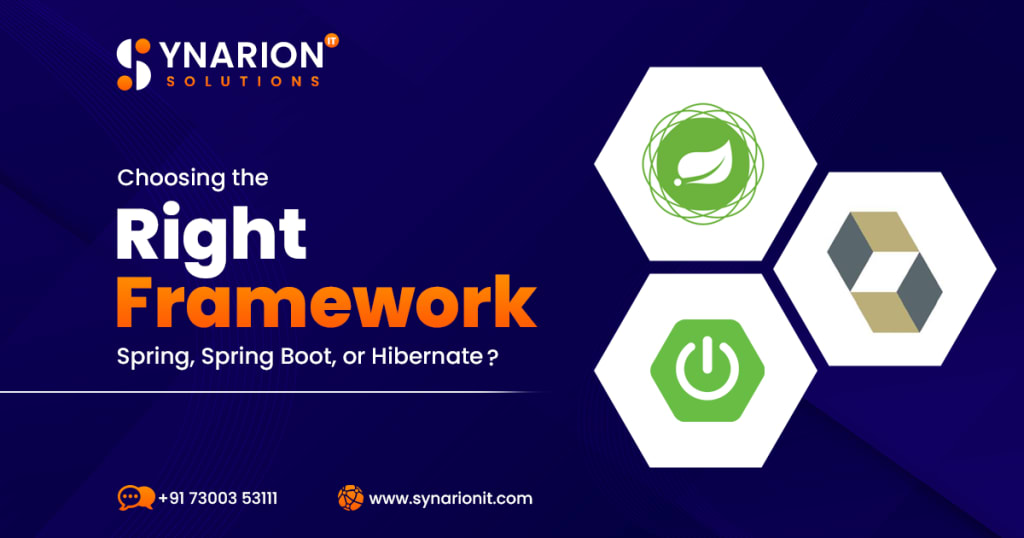Choosing the Right Framework: Spring, Spring Boot, or Hibernate?
A Complete Guide

In the realm of Java development, selecting the appropriate framework is crucial for building robust and scalable applications. Among the plethora of options available, Spring, Spring Boot, and Hibernate stand out as widely used frameworks that streamline development processes and enhance efficiency. Each framework has its unique features and advantages, making the decision-making process challenging for developers. In this article, we'll delve into what these frameworks entail, their differences, and factors to consider when choosing the right one for your project.
What Do You Mean by Spring Framework?
Spring Framework, often referred to simply as Spring, is a comprehensive and modular framework for Java application development. Invented by Rod Johnson in 2003, Spring has evolved into one of the most well-known frameworks in the Java ecosystem. At its core, Spring provides infrastructure support for developing Java applications, offering features such as dependency injection, aspect-oriented programming, and transaction management. Its modular architecture allows developers to selectively use the components they need, promoting flexibility and ease of integration with other frameworks and libraries.
What is Spring Boot?
Spring Boot, introduced by the Spring team in 2014, builds upon the foundation of the Spring Framework to simplify the development of stand-alone, production-ready Spring-based applications. It aims to minimize configuration overhead by providing auto-configuration capabilities and opinionated defaults. With Spring Boot, programmers can create self-contained and executable JAR files with embedded application servers, reducing deployment complexity. Additionally, Spring Boot includes a range of features such as built-in monitoring, metrics, and health checks, enabling developers to rapidly build and deploy microservices and web applications.
What is Hibernate?
Hibernate is a powerful object-relational mapping (ORM) framework for Java that simplifies database interaction by mapping Java objects to database tables and vice versa. Developed by Gavin King in 2001, Hibernate abstracts away the complexities of SQL queries and database transactions, allowing developers to work with objects rather than raw database tables. By providing a high-level, object-oriented approach to database access, Hibernate enhances productivity and maintainability while ensuring portability across different database platforms. It supports various mapping strategies, including annotations and XML configuration, and integrates seamlessly with other Java frameworks such as Spring.
Key Difference Between Spring vs Spring Boot vs Hibernate
Purpose and Focus:
Spring Framework primarily focuses on providing infrastructure support for Java applications, including dependency injection and aspect-oriented programming. Spring Boot, on the other hand, is designed to simplify the development of production-ready Spring applications by reducing configuration overhead. Hibernate specializes in object-relational mapping, facilitating database interaction in Java applications.
Configuration:
Spring Framework requires explicit configuration for various components, promoting flexibility but also increasing configuration complexity. In contrast, Spring Boot emphasizes convention over configuration, providing auto-configuration capabilities to streamline development. Hibernate simplifies database configuration by abstracting away SQL queries and database transactions, enabling developers to work with objects rather than raw database tables.
Deployment:
Spring Framework applications typically require external application servers, such as Apache Tomcat or Jetty, for deployment. Spring Boot, however, allows developers to create self-contained and executable JAR files with embedded application servers, reducing deployment complexity and dependencies. Hibernate does not directly influence deployment, as its focus is on database interaction rather than application deployment.
Learning Curve:
Spring Framework's modular architecture offers a steep learning curve due to its extensive features and configurations. Spring Boot simplifies the development process by providing opinionated defaults and reducing the need for manual configuration, making it more accessible to beginners. Hibernate's learning curve is primarily associated with understanding object-relational mapping concepts and mapping strategies.
Integration:
Spring Framework seamlessly integrates with various other frameworks and libraries, including Hibernate, to provide comprehensive support for Java application development. Spring Boot simplifies integration by providing out-of-the-box support for commonly used technologies and libraries. Hibernate integrates with Spring and other Java frameworks to provide ORM capabilities, enabling developers to leverage object-oriented programming paradigms in database interaction.
Conclusion
In conclusion, choosing the right framework—whether it's Spring, Spring Boot, or Hibernate—depends on factors such as project requirements, development expertise, and deployment considerations. Spring Framework offers comprehensive infrastructure support for Java applications, while Spring Boot simplifies the development process by reducing configuration overhead. Hibernate facilitates database interaction by abstracting away SQL queries and providing object-relational mapping capabilities. By understanding the differences and strengths of each framework, developers can make informed decisions to build scalable, maintainable, and efficient Java applications.
About the Creator
Vajid Khan
Passionate digital marketer with a flair for creating impactful online strategies. Proven expertise in SEO, SEM, and social media marketing, driving brand visibility and engagement.






Comments
There are no comments for this story
Be the first to respond and start the conversation.